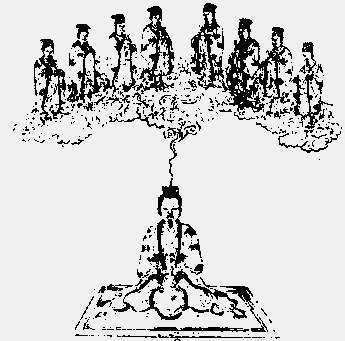"Gods are real and these gods are everywhere
in all aspects of human existence and in all
aspects of human life."
- James Hillman, polytheistic myth as psychology.
As some one who has studied molecular biology I know how absurd is the claim that gods reside in our bodies. But when we view science as only the mere appearances of phenomena and religion as the noumena that exists independent of us the claim that gods reside in our bodies doesn't appear to be as absurd as it seems at first.
Theurgy, sacred words and alchemy indeed works if you press the right button at the right time. How is it that people can make an ascent to the third heaven? How is it that by mere recital of the sacred words one achieves such a high efficacy over nature? All this is possible not by magic but by understanding the gods that govern our bodies and the cosmos.
This is the view which Neo-platonism of Iamblichus, Vedas, Gnostic Christianity, Taoism and Buddhism wants us to embrace.
Carl Jung, the Christian gnostic figured out his theory of individuation based on his extensive studies on these religions.
"Jung's work on himself and his patients convinced him that life has a spiritual purpose beyond material goals. Our main task, he believed, is to discover and fulfill our deep innate potential.
Based on his study of Christianity, Hinduism, Buddhism, Gnosticism, Taoism, and other traditions, Jung believed that this journey of transformation, which he called individuation, is at the mystical heart of all religions. It is a journey to meet the self and at the same time to meet the Divine. Unlike Freud's objectivist worldview, Jung's pantheism may have led him to believe that spiritual experience was essential to our well-being, as he specifically identifies individual human life with the universe as a whole. Jung's ideas on religion gave a counterbalance to the Freudian scepticism on religion. Jung's idea of religion as a practical road to individuation has been quite popular, and is still treated in modern textbooks on the psychology of religion, though his ideas have also been criticized"
- Carl Jung
Conclusion of Gnosticism
If anyone becomes a son of the bridal chamber, he will receive the light. If anyone does not receive it while he is here, he will not be able to receive it in the other place. He who will receive that light will not be seen, nor can he be detained. And none shall be able to torment a person like this, even while he dwells in the world. And again when he leaves the world, he has already received the truth in the images. The world has become the Aeon (eternal realm), for the Aeon is fullness for him. This is the way it is: it is revealed to him alone, not hidden in the darkness and the night, but hidden in a perfect day and a holy light.- Gospel of Philip
I must admit that this is where the gnostic and the vedic thought reaches its ultimate climax, the whole macrocosm (cosmos) is reduced to a single deity in whom all the fullness dwells and this is the process of becoming one with the Father and his cosmos, only then you will know that you are none other than unity itself.
This is the meaning of the statement,
"People cannot see anything in the real realm unless they become it, if you have seen Christ you have become Christ, if you have seen the spirit you have become the spirit, if you have seen the Father you will become the Father"
- Gospel of Philip.
The deity at the centre of the Mandala
For example:
No scholar of western hemisphere up to now as understood the secret meaning of the mandala other than Carl Jung, only a gnostic like Carl Jung could have understood it, its quite obvious that for an immature western mind the concept appears completely alien to them.
Mandala of the east is the Pleroma of the west and it was discovered by the Vedic Aryans
While Tibetan Buddhism and Tantric Hinduism have converted the concept of Mandala into imagery and art, Gnostic Christianity and the Vedic Aryans have preserved the true meaning of the Mandala as the fullness (Pleroma) that dwells in the body of Christ. One doesn't have to make complex diagrams and computer generated 3D models of mandalas to receive redemption. All that one need is a pneumatic heart and a grace of the pneumatic Christ, a beautiful message purported by the greatest apostle Saint Paul, it is indeed a good news.
Conclusion of Hinduism
Om dhyeya sada savitra mandala madhyavarti narayana sarasija sanasanni vistah
keyuravana makarakundalavana kiriti hari hiranmaya vapura dhrtasamkha cakrah
We worship Savithru (Sun God) as the deity who always resides at the center of the savithru mandala whose body is formed by all the Aeons of the Pleroma.


No comments :
Post a Comment